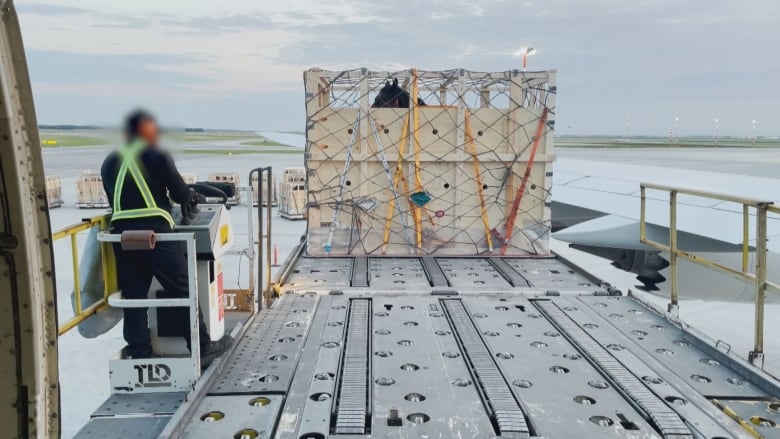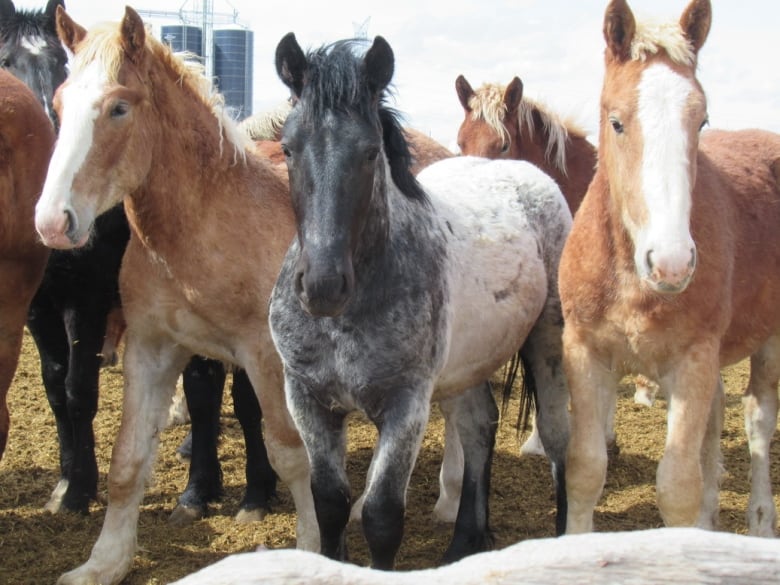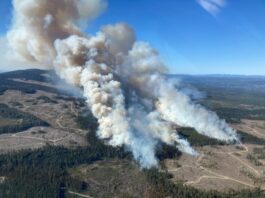
Confined in wooden crates, 99 horses were loaded into an airplane’s cargo hold at the Edmonton International Airport last month.
Like thousands of others before them, the animals were bound for Japan where their meat, served raw, is considered a delicacy.
Horse welfare advocates are hoping the shipment will be one of the last.
“When horses for slaughter are shipped, they are crammed into these crates,” said Sinikka Crosland, president of the Canadian Horse Defence Coalition.
“It’s a horrific journey.”
Live exports are banned in the United States and Britain, and horse advocates who condemn the slaughter have long called on Canada to follow suit. As Ottawa mulls a proposed a ban on live exports for slaughter, horse activists and industry advocates are clashing over whether a ban is justified and the potential consequences.
Canada is among the leading exporters of horsemeat in the world. Thousands of horses — raised solely for slaughter — are shipped out of the country each year. It’s a lucrative but controversial multimillion-dollar business that is now facing an uncertain future.
Prime Minister Justin Trudeau, in a December 2021 mandate letter to Agriculture Minister Marie-Claude Bibeau, vowed to end exports of live horses for slaughter.
The Prime Minister’s Office is supporting a private member’s bill tabled by Liberal MP Tim Louis in September calling on the government to make good on that promise. Lawrence MacAulay, who took over from Bibeau as Canada’s agriculture minister this summer, has said he takes the issue, and animal welfare, seriously.
The bill calls for a prohibition on the export of horses for slaughter, with fines of up to $250,000 or a two-year jail term for people found guilty of participating in the trade.
Domestic slaughter would be untouched by the proposed legislation.
The food chain
Horsemeat, described as soft and sweet, is considered taboo to many North American palates but it’s no stranger to Canadian kitchens.
Especially popular in Quebec, the meat is stocked in grocery stores and butcher shops and can be found on the menus of high-end restaurants across the country.
The vast majority of consumer demand, however, can be found overseas with live exports accounting for the bulk of the Canadian industry.
Horses can be sold into meat production and slaughtered for the domestic market.
Animals destined for live export, however, are purpose-bred and begin their lives on sprawling feedlots.
There are two remaining slaughter plants in Canada — Viande Richelieu in Massueville, Que., and Bouvry Exports Ltd., in southern Alberta. Bouvry operates the largest horse slaughter plant in the country. It’s surrounded by feedlots for the horses that serve its supply chain. The company declined to participate in an interview with CBC.
By the numbers
More than 85 per cent of Canada’s horsemeat is exported. According to the Canadian Meat Council, major markets include Japan, Switzerland, France, Belgium and Kazakhstan.
Horses are shipped by air from Calgary, Edmonton and Winnipeg to Japan where they can fetch up to $9,000 each.
According to Statistics Canada, about 2,600 Canadian horses were exported for slaughter in 2022.
All went to Japan, at a total value of $19 million.
Data collected by Agriculture and Agri-Food Canada shows that between January and March of this year, 899 horses were shipped out of the country.
The Canadian Food Inspection Agency (CFIA) says 45,000 horses destined for slaughter were shipped abroad between 2013 and 2023.
The journey
The journey for horses destined for slaughter begins at the feedlot.
Mostly Clydesdales and Percherons, horses are loaded onto trucks and delivered to the airport tarmac where they examined for signs of disease. The animals selected for transport are loaded into wooden crates and packed into the plane’s cargo hold.
After they arrive in Japan, the horses are fattened for at least three months before they are slaughtered. Their meat, served uncooked, is coveted by consumers who pay upwards of $45 per kilogram for the delicacy.
Called basashi, it has earned the nickname “cherry blossom meat” for its unique flavour and texture.

Canadian food export regulations dictate that the animals in transit should spend no more than 28 hours without food, water or rest. Prior to February 2020, the maximum transport time was 36 hours.
The CFIA says it monitors the shipments closely and that strict health checks ensure the welfare of the animals aboard each flight.
Horses spend, on average, 20 to 22 hours in transit, according to the CFIA. Five deaths in transit have been reported to the agency over the past decade. The mortality rate at all stages of transport is 0.011 per cent, the agency said.
Welfare fears
Animal welfare advocates filed a legal complaint with the federal government after a December 2022 shipment of live horses from Winnipeg to Japan exceeded the 28-hour limit.
The complaint, and a petition promoted by Canadian singer-songwriter Jann Arden, have helped throw calls for a ban back into the spotlight.
Crosland, president of the non-profit advocacy group Canadian Horse Defence Coalition, said the conditions in transit are cruel. Horses are prone to panic and don’t cope well with confinement, she said.
The coalition is seeking an outright ban on the horse slaughter but considers live exports particularly problematic.
The group has been monitoring the transports for years, gathering records and capturing video footage of the shipments.
Too often, regulations are broken and time limits on transports exceeded, Crosland said.
“Often, they’re sitting on the tarmac for hours,” she said. “They have no food, water or rest.”
Regulations under scrutiny
Industry advocates say the sector is an important part of Canada’s livestock economy, one that has been unfairly maligned by activists.
Jennifer Woods, a Calgary-based livestock handling expert who conducts animal welfare audits for the transport industry, said exports are strictly regulated and conditions are humane.
Japan doesn’t accept live horse exports from any country other than Canada. The Japanese market is particularly obsessed with quality, Woods said.
“There are so many checks and balances,” she said.
“It really comes down to the end use of the animal. And the end use of an animal should not define what their welfare is during their life.”
More than 45 standards regulating the density of shipping, length of transport and overall animal health are enforced, Woods said.
For example, loading density regulations enforced by the International Air Transport Association require that horses weighing around 725 kilograms be given 1.7 square metres of space when transported in crates that hold three animals.
When they are shipped to Japan, horses are provided with more than two sq. m of space when loaded three to a crate, she said.
Woods said thousands of animals exported from the country every year under similar conditions.
“We export pigs, we export cattle, and we export them all under the same regulations and requirements so I just really struggle with the idea that air transport is only inhumane when it’s export horses bound for Japan’s meat market,” Woods said.
“We don’t all have to agree on whether horses should be consumed for meat. Nobody has to agree on that. But we should agree that regulations and bills are actually based on facts.”

Bill DesBarres, chair of the Horse Welfare Alliance of Canada, opposes a ban on live exports.
He said the horsemeat industry is no different than any other aspect of the livestock industry, and the sector is being unfairly villainized.
DesBarres spent decades breeding Appaloosas near Medicine Hat, Alta. When his operation was still active, he sold a handful of old horses each year for domestic slaughter. He said he enjoys eating a variety of meat, including horse.
He said the domestic market provides a humane and useful end-of-life option for animals that old or sick.
We raise livestock to provide a source of protein to humans who want to eat it.– Bill DesBarres
“I respect many people who would rather not eat any meat,” he said. “That’s fine. That’s their privilege and their prerogative.
“But we raise livestock to provide a source of protein to humans who want to eat it.”
DesBarres said it’s frustrating to see politics pose a threat to suppliers and breeders across the country. “A lot of people fear for their business and their livelihoods,” he said.
A question of culture?
Dylan Gordon, a Halifax-based anthropologist and food culture researcher, said the proposed ban raises important questions around the politics of food and which animals are considered of value.
When people view animals as companions, the idea of eating them becomes morally abhorrent, he said.
Gordon cautioned, however, that the current debate over the Japanese market’s appetite for raw horsemeat echoes historic, xenophobic beliefs while neglecting other problematic practices within Canada’s meat industry.
He said it’s important that Canadians think critically about their own food choices.
“Don’t demonize other people for not eating the same way you do, because there’s plenty of issues in our own backyard.”












